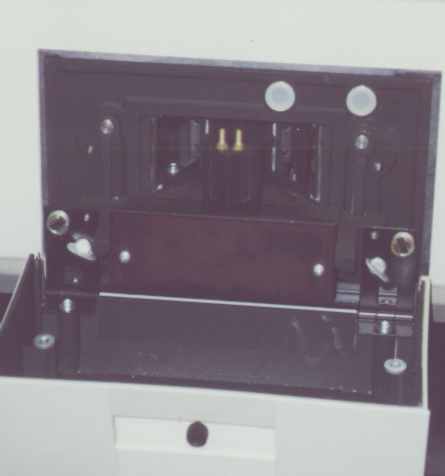
Sample compartment of PerkinElmer L-50 spectrofluorimeter
The applicable form of the Stern-Volmer equation that you will use to determine the quenching rate constant is
Io / I = 1 + K [Cl-]
where Io is the intensity without quencher, I is the intensity with quencher .
It is apparent from this equation that a graph of the ratio of the fluorescence intensity without salt to that with salt plotted against the concentration of salt will give a straight line with a slope of K.
The quantum yield is related to the intensity of a fluorescence peak by the factor (1-10–A) where A is the absorbance of quinine at the excitation wavelength. If you assume the factor is small, you can estimate the rate constant from the ratios of the fluorescence peak heights as follows. Taking into account the lifetime of fluorescence , the quenching constant K can be written as
K = Kq x t , where Kq is the 2nd order quenching rate constant and t is the fluorescence lifetime of quinine (19.02 ns) :
K = Kq x 19.02 x 10–9 s
You might want to measure the absorbance of the quinine solution you use for the quenching study at the excitation wavelength and correct the fluorescence peak height data.
A diffusion controlled rate constant pertains to a chemical reaction
in which the reactants react as quickly as they are able to diffuse through
the solvent and come in contact with one another. If the quenching
rate constant is the same as the diffusion-controlled rate constant, one
interpretation would be that every collision between an excited quinine
molecule and a chloride ion results in a transfer of energy from the quinine
(so it does not fluoresce) to the chloride.
Under this model, it would be impossible for the quenching rate to
exceed the diffusion-controlled rate (they can’t react if they can’t get
together).
Preparation of solutions:
1 mM quinine in 0.05 M sulfuric acid – standard solution
0.0001 mM quinine in sulfuric acid is a good starting point for measurements.